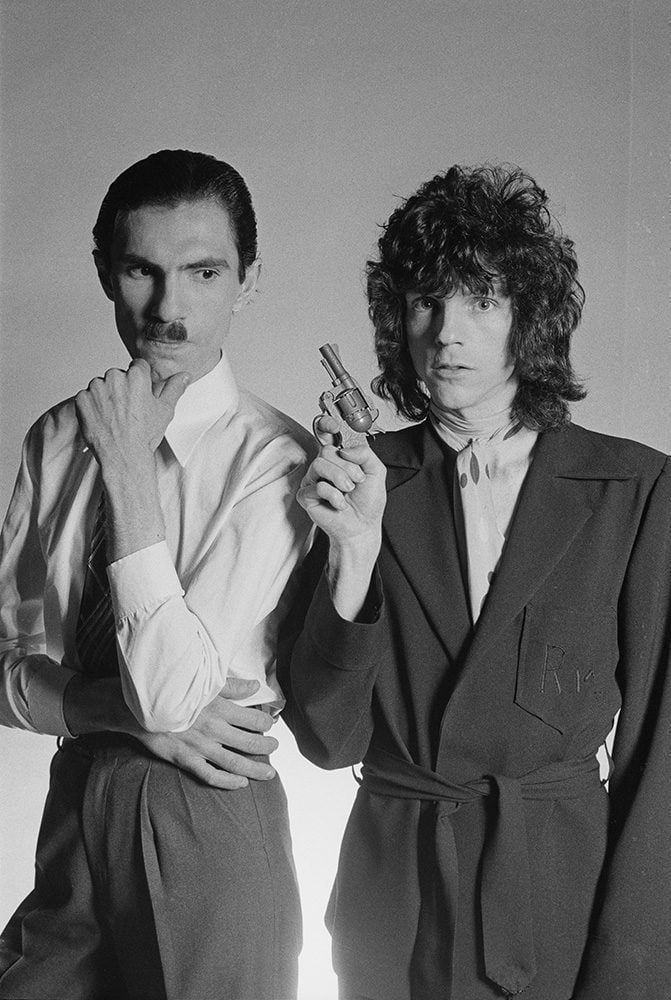
A Theatrical, High-Camp Masterpiece of Musical Confrontation and Glam Rock Excess
The Clash of Personalities and Stylistic Grandeur
Ah, 1974. What a year for pop music! The airwaves were still heady with the remnants of Glam Rock‘s glitter and stomp, but something truly different was bubbling up from the transatlantic duo, the brothers Ron and Russell Mael, better known as Sparks. They had already released a couple of albums, but it was with the dramatic, operatic explosion of “This Town Ain’t Big Enough for Both of Us” that they truly seized the British imagination and carved their own utterly unique niche. This single, the opening track and lead single from their breakthrough album, Kimono My House, was not merely a song; it was a three-minute, high-camp warning shot across the bow of conventional pop music.
The song shot up the UK Singles Chart, peaking gloriously at Number 2, a remarkable feat for a track so wonderfully, uncompromisingly strange. While it sadly failed to break the Billboard Hot 100 in their native United States, its European success—especially in the UK, where it stayed at Number 2 for two consecutive weeks—cemented the Sparks phenomenon. It was a smash hit that defied every expectation of what a smash hit should be.
A Duel Inspired by Western Clichés
The genesis of “This Town Ain’t Big Enough for Both of Us” lies in the acerbic, witty mind of songwriter and keyboardist Ron Mael. The title itself is a brilliant subversion, taken from the quintessential, well-worn cliché of a Western movie showdown, the ultimate challenge from one gunfighter to another. Ron initially toyed with the idea of having each verse feature a different cinematic cliché, but wisely streamlined the concept to focus on this one unforgettable line, making it a recurring, emphatic chorus. The song, therefore, is a lyrical duel, a tense, escalating confrontation between two figures—a lover and a rival, or perhaps even two aspects of the singer’s own personality—all set to a dizzying musical backdrop.
The producer, Muff Winwood, amplified this cinematic theme by adding distinctive, Western-style gunshot sound effects to the track, a flourish that only intensified the sense of theatrical absurdity and imminent danger. The lyrics themselves are a breathless, often surreal stream of words, packed with Ron’s trademark humor and arcane imagery—lines about “tacky tigers” and a “khaki-coloured bombardier” leaving listeners scrambling to keep up with the narrative pace, yet utterly captivated by the drama.
The Falsetto That Defied All Rules
The most immediately arresting feature of the song, and its enduring trademark, is the vocal performance by Russell Mael. Ron Mael famously composed the song in a high key, A-major, without any regard for his brother’s vocal range. Russell, rather than requesting a transposition to a more traditional ‘rock’ key, famously made the adjustment himself, forcing his voice into that distinctive, octave-leaping falsetto. This untrained, non-traditional vocal approach—staccato, dramatic, and pushed to its very limit—perfectly captured the song’s hysterical, manic energy. The combination of Ron’s intricate, rhythmic keyboard work and Russell’s unique, high-pitched delivery made the song truly atypical for the time, an avant-garde pop track that challenged the listener’s expectations of the standard verse-chorus structure. It was a provocative, glorious rejection of the status quo, announcing that Sparks were a band operating on a completely different plane.
For those of us who remember it hitting the charts, its sound was an electric shock, a theatrical jolt that cut through the predictable rock of the era. It was weird, wonderful, and undeniably a work of genius, one that, five decades later, retains all its bizarre charm and power. It’s a memory of a time when pop music could still genuinely shock and delight in equal measure, a moment when two brothers from Los Angeles reinvented themselves and, however briefly, made a high-art freak-out the second-biggest song in the country.